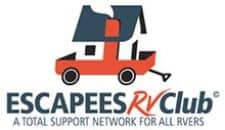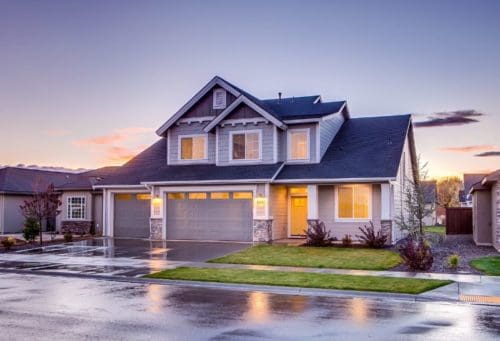Yup, I lived in one! It was magical. I personally found the freedom of movement to be one of the best things I ever did in my life. I was able to travel extensively through countries that I never would have gone to otherwise.
From one Tiny House owner to another … here are my answers to some of the most common Tiny Home FAQs!
1. WHAT IS A TINY HOUSE?
A Tiny House is a term for a small home which can be built on a trailer or have its own foundations. Its square footage usually does not surpass 400 square feet.
2. WHAT IS THE USUAL SIZE FOR A TINY HOUSE?
Most range from 120 square feet to 400 square feet.
Tiny Houses built on trailers rarely exceed 32’ in length, 8.5’ in width, and 13.5’ for height. Anything larger is usually built as a Park Model RV or a mobile home.
If you build on a foundation, your Tiny House can be bigger, up to 400 square feet (per Appendix Q of the IBC). After 400 square feet, it’s no longer considered a Tiny Home.
One space-saving trick is that there are smaller versions of regular household appliances that can be used to save space. For example, instead of having a regular-size fridge, you can purchase a mini-fridge.
3. HOW MUCH DOES A TINY HOUSE COST?
Professionally built Tiny Houses cost between $30,000 and $200,000. Costs start at $100 per square foot for the most basic models; most commercial models are $300 – $400 per square foot.
Building your own Tiny House tends to cost less at around $15,000 to $25,000 in the price of materials. Your time is free, right?
4. WHAT KIND OF TOILETS DO PEOPLE USE IN A TINY HOUSE?
Most people will choose to use either composting toilets or septic waste tanks similar to those used on RVs.
- The composting toilet uses the natural process of decomposition to turn your waste into compost. It is an ecologically friendly and sustainable method of getting rid of your waste. The Nature’s Head composting toilet is a popular option. You can also devise your own.
- Another option is an incinerating toilet. These can be electric or gas-powered units and do not require water. They work by incinerating the waste. Each flush costs about 10 cents worth of propane. They are slightly expensive as they are easy to use and the ash can be disposed of wherever.
- Cassette toilets are similar to those used in RVs. Waste is stored in a 5-gallon cassette tank that can be removed to empty it. These are suitable for people moving around a lot.
5. HOW DO I HEAT AND COOL MY TINY HOUSE?
The creme de la creme of Tiny Home HVAC is a mini-split air conditioner heat pump, which can both heat in the winter and cool in the summer. They are energy-efficient and nearly silent. However, you will need one professionally installed to maintain its warranty.
Most Tiny Houses use either electric space heaters or propane heaters.
- An electric space heater slowly heats up the air and is silent. However, it cannot run off propane.
- A catalytic propane heater is a great affordable choice, but you’ll need one per room.
- On the other hand, forced air heaters are louder but are great to heat up a space quickly. Look for a direct-vent propane furnace that produces about 20,000 BTU.
Other heating methods are wood stoves and kerosene heaters. Proper insulation in your Tiny House will ensure that even in winter your energy needs are low.
To cool a Tiny House, either invest in a small air conditioner or fan depending on your location. You’ll want an air conditioner between 8,000 and 18,000 BTU. Mini-splits are best, but window air conditioners and thru-the-wall units are popular options. Portable swamp coolers only work in dry, desert climates.
6. HOW TO FINANCE A TINY HOUSE
- Some banks will offer personal loans to help you finance your Tiny House.
- You can choose to borrow from friends and family.
- Once you move into your Tiny House, your cost of living will reduce.
- Other financing options include RV loans, peer-to-peer lending, or a home equity loan from your current residence.
Some manufacturing companies even offer financing! For example, Tumbleweed Houses offers a 15-year loan with an interest rate of 6.09% for those who can put 20% down.
To get a personal loan, check out LightStream and Rocket Mortgage, which can offer up to $100,000 for up to seven years.
7. IS IT POSSIBLE TO INSURE A TINY HOUSE?
Yes. More and more insurance companies are offering coverage.
If built by a reputable manufacturer, getting your Tiny House insured becomes much easier. Look for RVIA or NOAH certification.
To insure your Tiny House, check out Strategic Insurance Agency, Foremost, The Hartford, and Liberty Mutual.
8. CAN YOU BUY A TINY HOUSE OR DO YOU HAVE TO BUILD IT YOURSELF?
You can choose whether you want to build it yourself or hire a builder. Consider the overall costs in terms of money and time before making your decision. Building it yourself will give you the ultimate control in design (such as how you build the framing), but registration, certification, and insurance can become a nightmare!
Buying a house online is now easy with many online resources offering fast delivery. Examples of Tiny House builders include: Minimaliste, Rocky Mountain Tiny Houses, Custom Container Living, and New Frontier Tiny Homes.
9. ARE TINY HOUSES DIFFICULT TO MOVE TO A NEW LOCATION?
By building your Tiny House on a trailer, it makes it easier to move around. However, if they weigh over 10,000 lbs, you may require a special permit or license. Plus, very few passenger vehicles can tow a triple-axle Tiny House any real distance! This is a common THOW myth.
Taking your Tiny House on the road will take some time getting used to. For those that find driving a trailer difficult, there are other options. There are even Tiny House movers like Heavy Haulers and Tiny House Movers who will pick up and move your Tiny House to its new location.
10. SHOULD I BE ON-GRID OR OFF-GRID WHEN LIVING IN A TINY HOUSE?
Some Tiny House owners choose to live off-grid but this does require more planning. You will have to find ways of collecting fresh water and getting rid of waste.
Living on the grid makes it easier to get electricity, water, and to get rid of sewage. Try to give up on unnecessary items like blow dryers and clothes dryers to help further reduce consumption.
11. DO I HAVE TO PRODUCE MY OWN ENERGY?
If you live on the grid, you can just plug into power. If you can’t get mains power to your Tiny Home, consider using a 30A or 50A RV power pedestal.
If you live off the grid, most Tiny Houses will have back-up generators and use solar panels. The downsides of solar panels are they tend to be expensive, require quite a few panels, and need direct sunlight to work. However, when paired with a lithium or deep-cycle AGM battery bank, solar panels can often generate enough electricity to power an entire Tiny House!
12. HOW BAD DO COMPOSTING TOILETS SMELL?
It depends on the type of composting toilet. As technology improves, the smell has been drastically reduced. Some are built with electric fans to help suck away the odor. The Nature’s Head composting toilet is my recommendation. It doesn’t smell.
13. WHERE DO I STORE MY STUFF?
By owning a Tiny House, you are choosing to downsize your life. This means you will have to drastically reduce the number of belongings you own and use. That’s part of what attracts people to the Tiny Life!
Due to their size, Tiny Houses are designed with many of the living spaces being dual-purpose. Many Tiny Houses have secret storage compartments around the house.
Some of our favorite ideas include:
- A bench that is also a storage compartment and sitting area
- A roll-out cabinet that fits under a desk for all your work-related needs
- Or install a bar over the kitchen where you can hang utensils.
The best part about owning and designing a Tiny House is that it’s up to you!
14. CAN I LIVE IN A TINY HOUSE IF I HAVE CHILDREN?
Tiny Houses are great places for kids to grow up. Pick a spot with ample outdoor space. Your children have the opportunity to learn in different locations. What could be more fun than that?
Living in a Tiny House as a family will bring you closer as a family. Teaching your kids to live simply and focus on what’s truly important is an important life skill. Also, by owning your own home you show your children financial freedom. Just don’t forget the child-proofing!
15. CAN I LIVE IN A TINY HOUSE WITH A PET?
A Tiny House may lack space, but with the right set-up, owning a pet is easy(ish). Make sure your animals get enough exercise and outdoor time.
- Having lots of windows makes it seems like there is more space.
- You will want to ensure your Tiny House has an adequate heating and cooling system such as an air-conditioning unit in place.
- Most pet owners will opt for hard-surface floors which are harder to scratch and will last longer.
- There are a range of staircases and ramps options.
- You could also install a doggie/cat flap depending on where you live.
- If you need some privacy, install gates to section off parts of your home for privacy.
Check out this article for more advice on living the mobile life with pets!
16. IF MY TINY HOUSE IS ON WHEELS WON’T IT BE EASY FOR SOMEONE TO TOW IT AWAY?
To add security to your Tiny House, there are wheel locks and clamps to make it difficult for someone to just be able to tow your house away.
- Invest in a heavy-duty coupler lock, which prevents potential thieves from hooking up your Tiny House and driving off.
- You can also get a wheel chock lock to lock the wheels. These are extremely difficult to remove without the right key.
- A third thing you can do is install motion-activated security cameras. While you’re away, these security cameras can help you keep peace of mind that your Tiny House is safe.
- You can also install an alarm that will go off and call the police if someone were to try to break in.
As you can see, it’s not easy to steal a Tiny House, but it’s always better to take necessary precautions.
17. IS AN RV THE SAME AS A TINY HOUSE?
- A Tiny House is designed to be lived in permanently. In comparison, an RV is a temporary living arrangement usually used for extended travel.
- RVs usually have to be plugged in, and you can remove sewage via a hose at RV parks. Tiny Houses, on the other hand, are designed for long-term living and have generators, toilets, and water tanks.
- RVs are designed for convenience. Tiny Houses are built to last for people wanting to downsize their way of life and go ‘Tiny.’
18. HOW DID THE TINY HOUSE MOVEMENT START?
The Tiny House movement came from a general need and wish to simplify the modern way of life and to live in a more environmentally friendly way. It was an idea created by Allan Wexler in the 1970’s and was made popular by Netflix shows like Tiny House Nation.
The Tiny House movement is a social movement that encourages simpler living by reducing your living space and decluttering your life. By giving up on things that are unnecessary you will have more time to focus on what’s truly important!
19. WHO CAN LIVE IN A TINY HOUSE?
Anyone and everyone: From the young to the old, single to couples or families. Tiny Houses are meant for anyone choosing an alternative way of life.
It’s been shown that 89% of Tiny House owners have less credit card debt, while 55% have more savings compared to the average American.
Overall, a Tiny House consumes less electricity at about 7% compared to a traditional-sized home. Living in a Tiny House has benefits for your mind, body, soul – and wallet!
20. WHAT ARE THE MAIN REASONS TO GO TINY?
- Smaller impact on the environment. By moving to a Tiny House, you can reduce a household’s ecological footprint by up to 45%!
- Reduce unnecessary items in your life to focus on what’s important
- Freedom of movement. Relocate seasonally and escape the worst of the weather!
- Financial freedom and safety. A Tiny House costs 20% of an average-sized home.
- Simplify your way of life; find more of it!
21. SHOULD I USE TANSU STAIRS OR A LADDER IN MY TINY HOUSE?
Tansu stairs are a great way to save space. They are based on a Japanese concept of having wooden boxes stacked on top of each other to create a staircase. The boxes can be used for storage meaning the stairs become dual-purpose. They are generally safer than ladders and are great for children or the elderly.
Ladders, while they save space, are generally harder to use and cannot be used as storage.
22. HOW MANY BEDROOMS DOES A TINY HOUSE HAVE?
Most Tiny Houses on wheels will have one bedroom. If needed, the living room can be designed as an extra living space with a pull-out bed. This means it can be converted into a guest room or children’s bedroom during the night and then during the day can be used as a living space.
For houses built on a foundation, it’s easier to have more than one bedroom. You can even add a second story!
23. DO I NEED A SPECIAL PERMIT TO DRIVE MY TINY HOUSE ON WHEELS AROUND?
In most cases, a Tiny House on wheels is classified as a RV or cargo trailer and doesn’t require a special permit if it’s under 10,000 lbs.
You will need a truck that is capable of towing a large trailer and the proper attachments. In most states, the Tiny House is limited to 8.5 feet wide, 13.5 feet high and 40 to 65 feet long including the tow vehicle.
24. WHERE CAN I PARK MY TINY HOUSE?
The best place to park a Tiny House is either on your own land, a Tiny House village or at a RV park.
Tiny House villages are a great place to live as a Tiny House owner. Villages are sprouting up around the world as people are choosing the ‘Tiny Life.’ If you’re in America, check out: Tiny House Community California, Tiny House Community Texas, Escalante Village and Simply Home Community.
Choosing to park your Tiny House on your own property is the ideal or that of a friend or family member. If you own the land, you can park your Tiny House for the long term.
25. WHAT’S IT LIKE LIVING IN A TINY HOUSE?
I personally found the freedom of movement to be one of the best things I ever did in my life. I was able to travel extensively through countries that I never would have gone to otherwise. The material objects that I once thought were vital are no longer necessary.
26. WHAT’S IT LIKE TO TOW A TINY HOUSE?
A Tiny House on wheels is quite a large object to be driving around. It does depend on weather and road conditions too. Driving a Tiny House tends to be slow. You will be beeped a few times and most drivers will race around you. Take it easy and you will get the hang of it.
If you have a home that is between 20 and 28 feet, a GMC Sierra 2500, Dodge Ram 3500 or Ford F-350 are your best bet. You can choose to rent a truck if you do not own one. If you are not interested in moving your own tiny house, consider hiring a moving company.
27. WHAT DO YOU DO WITH ALL YOUR STUFF WHEN MOVING INTO A TINY HOUSE?
Go through your belongings and sort them into stuff you need and can live without. Keep the things that you require for day-to-day life. Read online tips such as how to downsize and tidy up your life before getting started.
Most first-time Tiny House owners will rent a storage unit for their first year. Once they are settled into Tiny House living then they can get rid of it.
Try to donate as much as possible. If a friend or a family member has a spare space, some of your most vital belongings can be stored there.
Cassandra Riddell is an experienced travel writer and marketing expert. A true digital nomad at heart she’s always on the go looking for the next destination to explore. You can usually find her outside, hiking or camping in beautiful settings. When she’s not working online, she’s a scuba diving instructor helping people uncover the beauty of the underwater world and educating people on how to protect it.
-
Cassandra Riddellhttps://changingears.com/author/cassandra-riddell/










